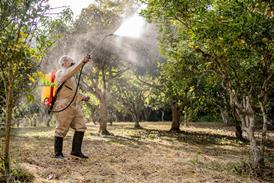Engaging the industry to tackle water shortages now means investing in research, then acting on it, says Joanne Denney-Finch
Food inflation is back in the headlines and as usual the source is water.
In 2007 the Australian wheat and rice crop was almost wiped out by drought, coinciding with low rainfall across Canada and Europe. Global wheat prices doubled and Sam's Club in the US began to ration rice. This year Russia is set to lose a quarter of its wheat yield to drought and the floods in Pakistan will cause a $1bn loss of crops.
With the supply of water fixed, populations rising steadily and extreme weather more frequent, the risk of a water crunch is very real.
We simply can't allow this to happen. We are the world's most important industry, employing a third of the population. And when it comes to water, the food industry is the key player.
Agriculture uses 70% of the world's fresh water. According to the International Water Management Institute, it takes 70 times more water to produce the food we eat compared with our other domestic needs, including drinking, cooking, bathing and cleaning. This isn't just farming's concern; we all share in the consequences. London is designated a "seriously water-stressed" region and the north west is now subject to a hosepipe ban.
According to Walter Todd, PepsiCo's vice president of sustainability for Europe: "In 15 to 20 years, companies in the UK that don't act will only be able to take so much water to run their operations. They may have their hours shortened or could be shut down."
Our industry must take the lead and indeed, many companies have. Coca-Cola has established community water partnerships in 70 countries. They're also one of several food and drink companies signed up to the UN's Water Mandate. Others have joined the Water Footprint Network or the Water Disclosure Project.
We're also seeing the benefits of past activities. Nestlé is using solar-powered sensors to help its Italian tomato suppliers. Yields have nearly doubled despite using 45% less water. Australian growers are using a technique called "partial rootzone drying" to produce grapes and other fruit with up to 50% less water. The flavour is also often enhanced.
In processing, Unilever has achieved a 65% reduction in water use per tonne of production since 1995 and Walkers a 42% reduction over six years. In retailing, M&S cut water use by 11%/sq m last year, and Sainsbury's is working to halve its water consumption by 2012.
I'm convinced we can avert a devastating water crunch but only if we deploy enough resource where it's most needed.
The International Crops Research Institute for the Semi-Arid-Tropics promotes science and best practice for arid area agriculture in Africa and Asia. Director general William Dar is confident that African farming could adapt to as much as 3C of warming, provided enough is invested in science, research and the transfer of knowledge.
We need to work together to protect against the dangers of interrupted supply and declining quality. IGD has established a working group designed to share best practice and is producing a guide to understanding, assessing and managing water in grocery supply chains.
Let's heed the warnings and move water to the top of our industry's agenda.
Joanne Denney-Finch is chief executive of IGD.
Food inflation is back in the headlines and as usual the source is water.
In 2007 the Australian wheat and rice crop was almost wiped out by drought, coinciding with low rainfall across Canada and Europe. Global wheat prices doubled and Sam's Club in the US began to ration rice. This year Russia is set to lose a quarter of its wheat yield to drought and the floods in Pakistan will cause a $1bn loss of crops.
With the supply of water fixed, populations rising steadily and extreme weather more frequent, the risk of a water crunch is very real.
We simply can't allow this to happen. We are the world's most important industry, employing a third of the population. And when it comes to water, the food industry is the key player.
Agriculture uses 70% of the world's fresh water. According to the International Water Management Institute, it takes 70 times more water to produce the food we eat compared with our other domestic needs, including drinking, cooking, bathing and cleaning. This isn't just farming's concern; we all share in the consequences. London is designated a "seriously water-stressed" region and the north west is now subject to a hosepipe ban.
According to Walter Todd, PepsiCo's vice president of sustainability for Europe: "In 15 to 20 years, companies in the UK that don't act will only be able to take so much water to run their operations. They may have their hours shortened or could be shut down."
Our industry must take the lead and indeed, many companies have. Coca-Cola has established community water partnerships in 70 countries. They're also one of several food and drink companies signed up to the UN's Water Mandate. Others have joined the Water Footprint Network or the Water Disclosure Project.
We're also seeing the benefits of past activities. Nestlé is using solar-powered sensors to help its Italian tomato suppliers. Yields have nearly doubled despite using 45% less water. Australian growers are using a technique called "partial rootzone drying" to produce grapes and other fruit with up to 50% less water. The flavour is also often enhanced.
In processing, Unilever has achieved a 65% reduction in water use per tonne of production since 1995 and Walkers a 42% reduction over six years. In retailing, M&S cut water use by 11%/sq m last year, and Sainsbury's is working to halve its water consumption by 2012.
I'm convinced we can avert a devastating water crunch but only if we deploy enough resource where it's most needed.
The International Crops Research Institute for the Semi-Arid-Tropics promotes science and best practice for arid area agriculture in Africa and Asia. Director general William Dar is confident that African farming could adapt to as much as 3C of warming, provided enough is invested in science, research and the transfer of knowledge.
We need to work together to protect against the dangers of interrupted supply and declining quality. IGD has established a working group designed to share best practice and is producing a guide to understanding, assessing and managing water in grocery supply chains.
Let's heed the warnings and move water to the top of our industry's agenda.
Joanne Denney-Finch is chief executive of IGD.













No comments yet